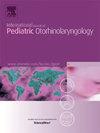Outcomes of laryngeal surgery in children with congenital laryngomalacia and neurological and neurodevelopmental comorbidities - A NSQIP analysis
IF 1.3
4区 医学
Q3 OTORHINOLARYNGOLOGY
International journal of pediatric otorhinolaryngology
Pub Date : 2025-07-09
DOI:10.1016/j.ijporl.2025.112483
引用次数: 0
Abstract
Introduction
Children with neurological and neurodevelopmental comorbidities (NNC) may experience poorer post-operative outcomes following the surgical management of laryngomalacia. The objective of this study is to assess short-term outcomes of this group.
Methods
A retrospective cohort study utilizing the American College of Surgeons National Surgical Quality Improvement Program – Pediatric Database years 2015–2023. Pediatric patients ages 18 and under were selected by CPT codes 31541 and 31561 and ICD-10 code Q31.5. NNC were defined as the presence of impaired cognitive status/developmental delay, seizure disorder, cerebral palsy, structural central nervous system abnormality, or neuromuscular disorder.
Results
A total of 5805 cases met the inclusion criteria, with 1229 cases involving patients with NNC. Patients with NNC were older at the time of surgery (14.7 vs. 4.1 months; p < 0.001), more frequently classified as American Society of Anesthesiologists class 3 (71 % vs. 46 %, p < 0.001), more likely to have cardiac risk factors (38.7 % vs. 13.2 %; p < 0.001) and to be born prematurely (31.5 % vs. 18.4 %; p < 0.001).
While controlling for sociodemographic and medical factors, children with NNC were at 2.85 times greater odds of developing post-operative pneumonia (95 % CI 1.36–6.01, p = 0.005), 2.35 times greater odds of requiring oxygen at discharge (95 % CI 1.61–3.44, p < 0.001), and 1.90 times greater odds of undergoing unplanned reintubation (95 % CI 1.04–3.45, p = 0.036).
Conclusion
Patients with NNC undergoing laryngeal surgery for laryngomalacia may be at a higher risk of postoperative complications, highlighting the importance of careful evaluation of surgical management and postoperative monitoring in this population.
患有先天性喉软化症和神经及神经发育合并症的儿童喉部手术的结果- NSQIP分析
患有神经和神经发育合并症(NNC)的儿童在手术治疗喉软化后可能会经历较差的术后结果。本研究的目的是评估该组的短期预后。方法采用2015-2023年美国外科医师学会国家手术质量改进计划-儿科数据库进行回顾性队列研究。患儿年龄在18岁及以下,CPT代码31541、31561,ICD-10代码Q31.5。NNC被定义为存在认知状态受损/发育迟缓、癫痫发作障碍、脑瘫、结构性中枢神经系统异常或神经肌肉障碍。结果5805例符合纳入标准,其中1229例为NNC患者。NNC患者在手术时年龄较大(14.7 vs 4.1个月;p & lt;0.001),更常被归类为美国麻醉医师学会3级(71%对46%,p <;0.001),更有可能有心脏危险因素(38.7% vs. 13.2%;p & lt;0.001)和早产(31.5% vs. 18.4%;p & lt;0.001)。在控制社会人口统计学和医学因素的情况下,NNC患儿发生术后肺炎的几率是术后肺炎的2.85倍(95% CI 1.36-6.01, p = 0.005),出院时需要吸氧的几率是术后肺炎的2.35倍(95% CI 1.61-3.44, p <;0.001),接受计划外再插管的几率高出1.90倍(95% CI 1.04-3.45, p = 0.036)。结论NNC患者行喉部手术治疗喉软化术后并发症的风险较高,强调了对该人群进行手术治疗和术后监测的重要性。
本文章由计算机程序翻译,如有差异,请以英文原文为准。
求助全文
约1分钟内获得全文
求助全文
来源期刊
CiteScore
3.20
自引率
6.70%
发文量
276
审稿时长
62 days
期刊介绍:
The purpose of the International Journal of Pediatric Otorhinolaryngology is to concentrate and disseminate information concerning prevention, cure and care of otorhinolaryngological disorders in infants and children due to developmental, degenerative, infectious, neoplastic, traumatic, social, psychiatric and economic causes. The Journal provides a medium for clinical and basic contributions in all of the areas of pediatric otorhinolaryngology. This includes medical and surgical otology, bronchoesophagology, laryngology, rhinology, diseases of the head and neck, and disorders of communication, including voice, speech and language disorders.

 求助内容:
求助内容: 应助结果提醒方式:
应助结果提醒方式:


